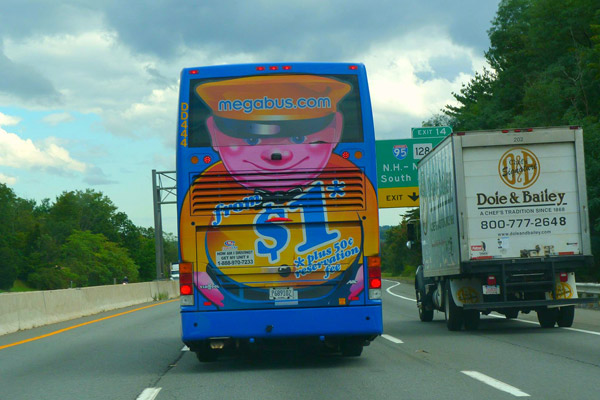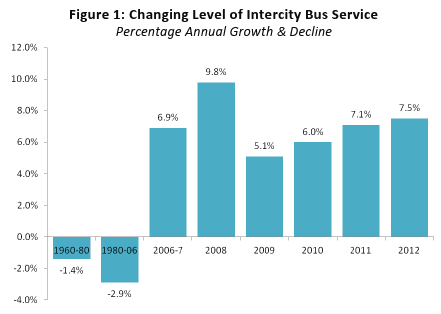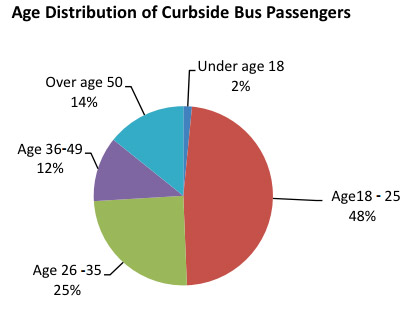
I used to take buses a lot: Vegas to Chicago and back, Chicago to Virginia, a long couple-weeks loop from Virginia to Chicago to several northeastern cities, Chicago to Atlanta. But I haven't been on a bus in a few years, because of my uniquely bad luck with fellow passengers. There was the time a guy cooking up in the stall next to me at the Chicago Greyhound station got dragged out under the door by a couple cops; the guy who got kicked off the bus for threatening to cut someone's heart out; the time I got woken up when the bus almost went into a spin; the time I got woken up by someone's hand covering my face; the guy with the white-supremacist tattoo at 4a.m. in rural Kentucky. Bus travel got a bit wearying after awhile, and I haven't been on one since 2007 or so.
Turns out I'm missing a trend (PDF, via):

That's from a new report by DePaul's Chaddick Institute for Metropolitan Development, which has been keeping tabs on intercity bus service for awhile now. It's a surprising recovery for an industry that looked to be in terminal decline:
In the 1960s, the number of intercity arrivals and departures exceeded that of commercial airlines as well as passenger railroads in major cities by a substantial margin. By the 1980s, most of the trains had been discontinued, but the number of departures by commercial airlines grew to such as extent that it generally exceeded the number of intercity bus departures by a factor of two.
Not all cities suffered to the same degree. In Chicago, the largest city in our sample, service dropped from 454 departures to 290 during this interval, a 36.2 percent decline. Chicago continued to be home to the country’s largest station operated by Greyhound, but the carrier’s daily activity there dropped from 287 to 186 buses.
In 1960, there were 454 daily arrivals and departures by bus in and out of Chicago. In 1980, 290; in 2002, 147 (O'Hare has about 2,400 flights every day). From 2002-2006, intercity bus service across the country declined eight percent. Then it turned around. What happened? It's a combination of a few things.
1. Megabus opened in 2006: 32 daily buses out of Chicago, rising to 42 in 2007. Megabus pushed stagnant giants to improve their service; Greyhound Express is an imitation of the Megabus model, with WiFi and dollar fares.
2. More interesting, to me at least: "the resurgence of central-business districts. Travelers too young to remember the stigma associated with bus travel, especially those living on college campuses and in large cities, are turning to motor coaches in especially large numbers." Airports tend to be well out of the way, and with Chicago excepted, time-consuming to get to. It takes two hours to fly from Chicago to New York… and then another hour to get from LaGuardia to midtown Manhattan. The Megabus stops a couple blocks from Penn Station.
And it's mostly young people. The Chaddick Institute surveyed "curbside" (i.e. Megabus, BoltBus) users (PDF), and the demographic is dramatic:

Five out of six are traveling for fun or personal matters; a majority are women, which is encouraging. The researchers attribute it to money, which I don't doubt, having been there, but I'm surprised they don't mention time. When I was in college, I could afford to spend 14-20 hours on a bus instead of six or seven flying (and waiting, and standing in lines). Once I started working, spending half a day in transit instead of a day or two was worth the money-for-vacation-days trade.
Photograph: Rusty Clark (CC by 2.0)


